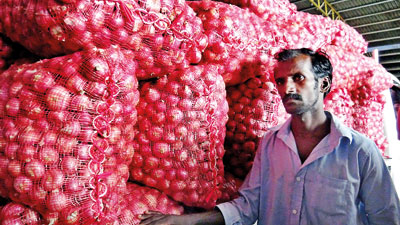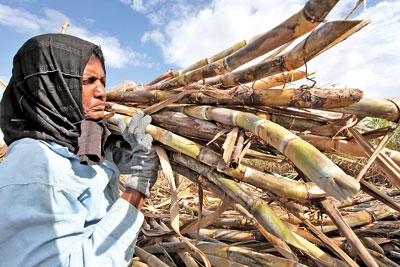Need to formulate proper agriculture plan
According to the Central Bank (CB) Annual report for 2016, the trade deficit has continued to increase from Rs. 979 billion in 2013 to Rs. 1325 billion in 2016. In view of the high external debt at nearly US$502 billion it is important that appropriate action is taken to reduce the trade deficit to solve at least partly the present financial crisis the country is facing.

Over-supply of onions. No proper storage means Sri Lanka lacks a proper agriculture marketing plan.
According to CB reports, our exports are classified into three main groups – industrial, agricultural and mineral. In 2016 agricultural exports constituted 2.2 per cent of the total exports. Imports constitute food and beverages, consumer goods and investment goods and in 2016, around 9.7 per cent of the imports were in the category of food and beverages. Hence in any plan to reduce trade deficit attention needs to be paid to increasing exports and reducing imports.
Increase export earnings
The dire need to increase export earnings to meet the severe financial crisis we are facing today has been emphasized by many including the Prime Minister and the Minister of Development Strategies and International Trade.
Exports have declined steadily from 27 per cent of GDP in 2000 to around 14 per cent of the GDP in 2016. Hence increasing exports is of paramount importance to improve our economy. But what we are going to export is the main question. CB reports indicate that the quantity of most of our exports has dwindled during the last few years. The amount of tea exported during the period 2013-2016 has continued to decrease from 319 million kg in 2013 to 288 million kg in 2016. It is unlikely that tea exports will increase substantially in the near future. Rubber exports too have decreased from 37 million kg in 2012 to 16 million kg in 2016. Exports of other crops too do not show any substantial increase during the last few years. All these data indicate that our exports are dwindling and it is sine qua non that an effective plan is implemented to increase our exports. Around 1200 Sri Lankan products would be benefited by the European Union (EU) decision to grant additional trade preferences to Sri Lanka under its GSP+ initiative.
In 2016, Sri Lanka exported Rs. 3.1 billion worth exports to EU in 2016. It is essential that relevant programmes are implemented early to promote the production of those products which have a potential for exports. A large number of crops other than tea, rubber and coconut cultivated in Sri Lanka have a high potential as export crops. Among these are the so called minor export crops such as pepper, cinnamon, horticultural and floricultural crops. In 2013, spice crops earned around $350 million.
Sri Lanka has a wide variation in soil and climate. There are 24 agro ecological zones, each characterised by specific climate and soils. This makes it possible to cultivate different types of crops like tuberous crops, horticultural and floricultural crops, medicinal herbs, etc which have a considerable export potential. There are many organisations such as the Ministries of Agriculture and Industry and Commerce, Export Development Board, Industrial Development Board, etc but there appears to be no proper plan to increase production of these crops.
Out of the 6.5 million hectares of land, around two million hectares are in the wet zone. About 75 per cent of it is cultivated and most of this land is of low-productivity due to soil degradation. In the dry zone, out of the 4.5 million hectares only about two million acres are in productive use. Thus, there is a large extent of potentially cultivable land in the dry zone. Most of the soils in the dry zone are relatively more fertile than those in the wet zone. Non-availability of adequate rainfall during the Yala season is one of the limiting factors of crop production in the dry zone. However, better water management practices would reduce this limitation. Also various major irrigation projects such as Mahaveli, Kirindioya, Muthukandiya and Inginimitiya provide irrigation to about 200,000 hectares in the dry zone.
The numerous minor irrigation projects too would increase the irrigable area in the dry zone. Thus, there is a considerable potential to increase the level of crop production in Sri Lanka.
Agro-industries
Promoting agro-industries will have a considerable positive impact on increasing exports. There is an urgent need to develop agro-industries in Sri Lanka, which will also have a tremendous impact on unemployment and rural poverty. A large number of crops cultivated in Sri Lanka including rice have considerable potential in various agro-industries. However only rubber, coconut and a few fruit crops are used in industries. Crops such as cassava, horticultural and floricultural crops, medicinal herbs, cane, bamboo, sunflower, castor, ayurvedic herbs, etc have considerable industrial potential but are not cultivated to any appreciable extent for want of better and improved varieties, technological know-how, relevant market information, etc. The private sector can be involved in such projects for which appropriate technical assistance needs to be given by the relevant public organisations.
However, there appears to be no proper long-term plan to develop agro-industries, except for some ad-hoc projects. The Ministries of Industries and agriculture should implement an effective Agro-Industrial Development Programme which undoubtedly would improve employment opportunities and incomes in the rural areas.
Small and medium term industries
Products of crop-based Small and Medium Enterprises (SMEs), have a high export potential and play a very important role in economic development of Sri Lanka because, they have the capacity to achieve rapid economic growth, while generating a considerable extent of employment opportunities.
Promotion of SMEs would result in increasing industrial output of the country leading to more exports. However, not much emphasis appears to have been placed on improving SMEs except providing loans by banks. A main factor which limits the SME sector is inadequate raw materials. For example cane is not available for those in this sub-sector. It is so in the other sub-sectors too.
While there has been a lot of rhetoric on promoting exports, only meaningful and effective actions will ensure results. Giving talks at numerous seminars, etc will not increase exports unless there is a realistic plan implemented effectively.

A woman carries cane at the Sevanagala Sugar factory.
Reducing imports
While increasing exports action also needs to be taken to reduce imports.
The expenditure on importing food has increased appreciably from Rs.150 billion in 2010 to around Rs.237 billion in 2016. The present expenditure on food imports is likely to be even more due to the depreciation of the rupee and drought.
Most of the food imported can be locally produced thereby reducing expenditure on food imports. For example, sugar production in the country has not increased by any appreciable amounts during the present decade.
Kanthale Sugar Factory remains closed while a plan to cultivate sugarcane in Bibile remains shelved. With regard to milk production we have around one million cattle consisting of mostly indigenous cattle. Their productivity is low (1-3 litres/day) mainly due to the poor nature of the breeds and inadequate low quality feed supply. The dairy industry has a potential to contribute considerably to Sri Lanka’s economic development. Milk production also plays an important role in alleviating nutritional poverty and it is a source of extensive employment opportunities. If milk production can be increased, an appreciable amount of foreign exchange spent on milk imports can be reduced and improve the nutrition status of the people. Although we say that we are self-sufficient in rice (a carbohydrate) a large amount of wheat flour (another carbohydrate) is imported at a cost of around Rs. 45 billion. Annual wheat consumption in the country has increased from 38 kg/per person to nearly 80 kg/per person.
There are many tuberous crops such as innala, sweet potato, yams which can replace a part of the wheat flour we import.
The expenditure on subsidiary crops such as chillies, green gram, ground nut, potato, etc is millions of rupees. The average per hectare yields and the extent of these crops have not increased to any appreciable amount during the last decade. A few years ago, a former Minister of Agricultural Development Chamal Rajapaksa appointed an Advisory Panel to make proposals to develop the agricultural sector so that there is a quantitative and qualitative increase in crop production at a lower cost with no damage to the environment. At the inaugural meeting of this Advisory Panel on Agriculture, consisting of 36 professionals in the agriculture sector, 47 recommendations were made. These recommendations were mainly on development and use of better varieties of seeds and planting material, effective control of weeds, insect pests and diseases, better water management, and water conservation, proper use of inorganic and organic fertilisers, controlling soil degradation and appropriate land use, promoting agro -industries, and carrying out relevant research and use of their findings.
During the last few years numerous programmes such as “AMA’, “Waga Sangramaya” and “Govi Sevana” were implemented. All these activities/programmes appear to have not made any appreciable positive impact on the agricultural sector of the country indicated by increasing expenditure on food.
Although hundreds of research projects related to agriculture are carried out by the faculties of agriculture, Department of Agriculture, etc there appears to be no organised system to utilize the research findings in our efforts to increase productivity in the agriculture sector. There is very little liaison/interaction among the relevant institutions and the agricultural research carried out in the country appears to have no appreciable positive impact on the food production level in the country. In a developing country such as Sri Lanka, a primary objective of scientific research must be to utilise locally available resources. Research priorities need to be based on the needs and problems in the production sectors.
However, in spite of organisations such as the Council for Agricultural Research Policy (CARP), National Science Foundation (NSF) the agricultural research efforts in Sri Lanka appear to have not been directed towards development of technologies to utilise local inputs in crop production.
The low productivity of crops can be attributed to a number of factors.
Among these are non-availability of good quality seeds/planting material, soil degradation causing a decline in soil fertility, high incidences of pests and diseases, water shortage, high costs of inputs such as seeds, fertilisers, pesticides, and labour, insufficient value addition/processing and difficulty of marketing at reasonable prices. In addition, ineffective research and extension, lack of planned crop production, insufficient attention to under-utilised crop varieties which have a potential in the local/overseas markets, ineffective utilisation of agricultural by-products also have contributed to the deterioration of the agricultural sector.
In spite of the rhetoric on agricultural development during the last few years the relevant institutes have not been able to provide fertiliser at the required times. It is meaningful and effective actions that are necessary. Increased agricultural production could be conceived of as an effective strategy for poverty alleviation, food security, reduction in unemployment, increase in foreign exchange earnings and rural incomes and improvement in income distribution. A concerted effort is necessary by all stakeholders to make the agriculture sector achieve sustainable development.
It is essential that the government is committed to increase agricultural production by formulating and implementing a realistic agricultural development plan.
(The writer is Foundation Professor of Agronomy – Ruhuna University and Foundation Professor of Soils and Water Resources – Rajarata University. Any comments can be sent to csweera@sltnet.lk).


